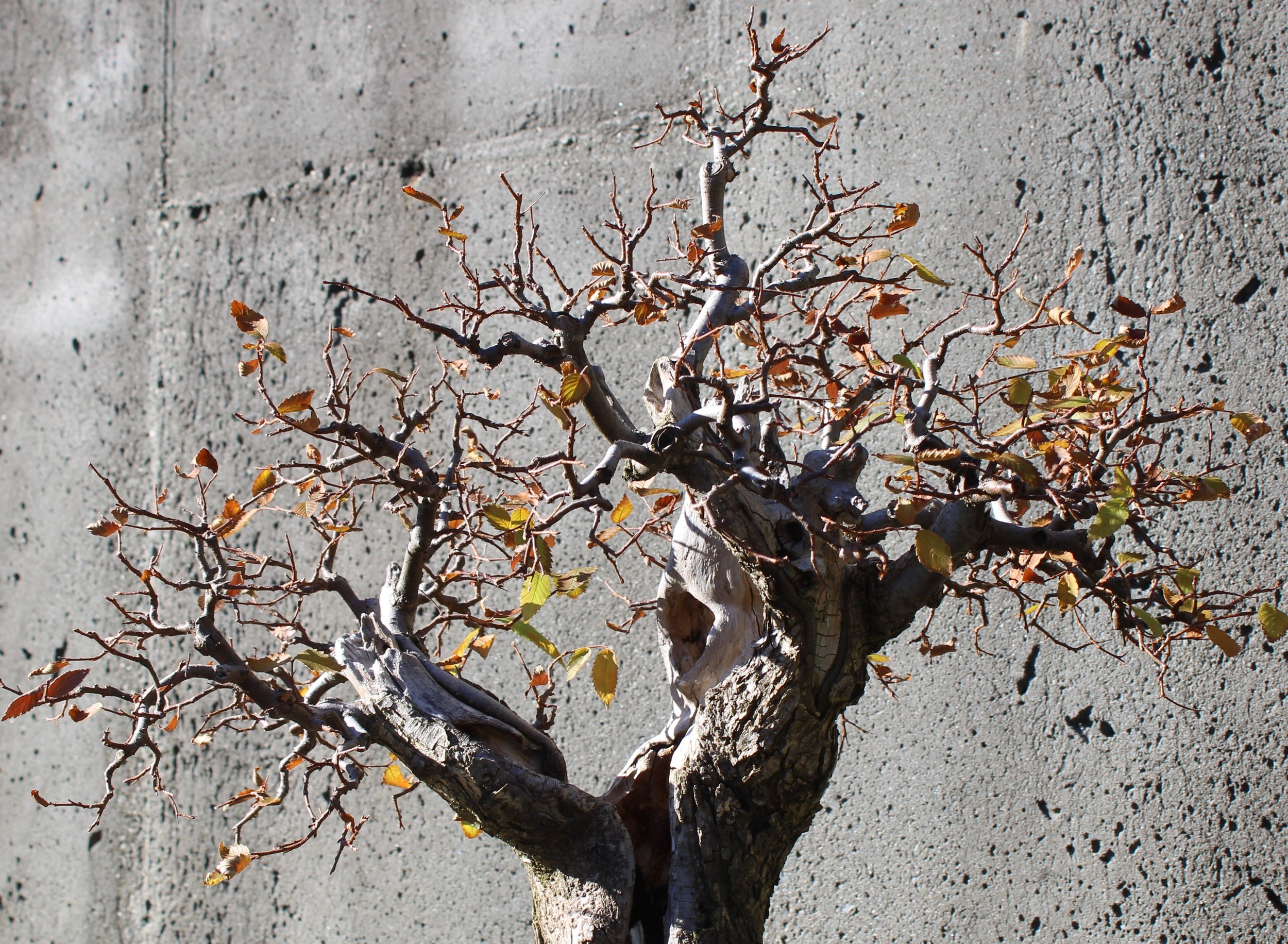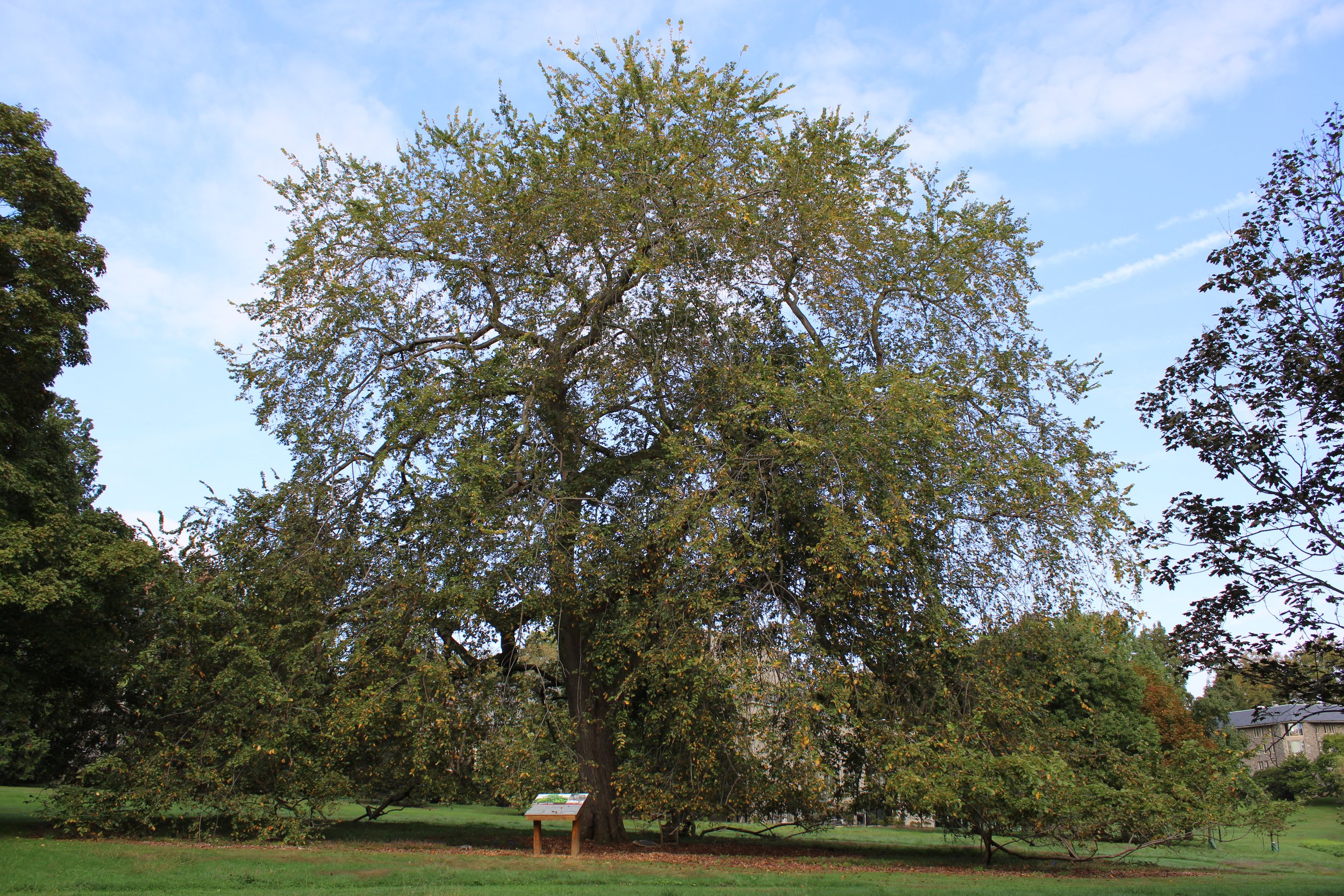Addendum
Author's note: In writing last week's entry about the American elm bonsai I chose to leave out certain information in order to streamline the storytelling. Subsequently it seemed to me the omitted material was worth relating, and so here it is.
I have never seen an American elm growing wild in the forest, or if I have I did not recognize it. This is entirely possible. Although I work to make myself better at tree identification, I remain at best only a student whose knowledge is limited to the tree species most common in my own small part of the world. If there are still American elms growing wild around here they must not be great in number.
I have, however, seen quite a few American elms growing in cultivation. One of the finest collections of such specimens is found in Central Park in Manhattan, which is said to be home to more than a thousand American elms. Some of them date back to the 1860s and were part of the original park plantings. Perhaps most notable are the rows of American elms lining the Central Park Mall and Literary Walk:
To walk along this avenue is to experience a sense of what made American elm the most popular street tree in the United States in the late nineteenth and early twentieth centuries. Tall, stately, with crowns so wide spreading they meet from either side of the street and form a living leafy archway that shades the lane below, these trees enclose the space and give it a feeling of comfort, no matter how crowded with people it might be.
American elms are also planted along the park side of the busy city streets that border Central Park, including Fifth Avenue. This photograph, a favorite among my own tree images, was made on Central Park West near the American Museum of Natural History:
The wild range of American elm covers much of North America, from Nova Scotia to Florida, and as far west as Montana and Texas. Not only is the species aesthetically attractive, it is adaptable, durable, large in its growth habit and long lived. It is easy to grow and unsurpassed as a shade tree, which is why it became so popular as a planting in parks and along urban and suburban streets. Here is a historical image of a city street lined with American elms early in the twentieth century:
What happened? Beginning around 1930 American elms started succumbing to an introduced fungal pathogen. The fungus is believed to have been native to Asia and found its way to Europe, New Zealand and North America via logs shipped from infected areas. The disease (misleadingly named Dutch Elm Disease because it was first identified by scientists in the Netherlands) is spread by bark beetles. All those elm-lined streets formed a monoculture environment through which the disease spread like wildfire, decimating all the elms in its path. It took a while for this to happen. Many American elms survived until the 1950s, 60s, and 70s, and here and there a few still do. Some individual trees have natural resistance to the disease, and some are growing in places where relative isolation protects them. There is some speculation that the elms in Central Park were spared because they are living in a virtual island of nature surrounded by a sprawling urban environment. More frequently, however, old American elms survive because of human intervention in the form of fungicides, insecticides (to control the vector), and other arboricultural measures. An example of this can be found in Washington D.C., where such measures have preserved the beautiful American elms lining the National Mall.
I knew something of Dutch Elm Disease and the demise of the American elm before I started working at the Arboretum, and before I knew anything about bonsai. The many elm-lined streets of the United States were being ravaged by the disease during the decades I was growing up and I heard talk of it. Occasionally a photo would turn up in the newspapers or magazines showing another sad neighborhood stripped bare of its street trees. When my wife and I bought our first house, near downtown Asheville, it had a mature American elm in the backyard. It was not old or very large, but it was healthy, at least for the first few years we lived there. One summer all the leaves on a sizable section of it turned yellow, then soon after withered and the branches died. The following year the same happened in several more areas of the crown. The next year the tree was completely dead.
When I found a lone American elm growing in a small plastic pot among the excess plants in the Arboretum's nursery, it had immediate appeal. The idea of making a bonsai out of a species so well known and badly troubled seemed a novelty, and at the very least it gave me the opportunity to protect this one individual tree. As a practical matter, though, it wasn't sound thinking. Nothing about that particular elm, little more than a stick in a pot, suggested it would in any way make a good bonsai. I speculated that it would work for the purpose because other elm species, particularly Chinese elm, were tried and true bonsai subjects. But not every Chinese elm makes a good bonsai, either. If a person wants to start a bonsai from very young plant material, the best way to go about it is to start out with a large number of them, as many as is practicably possible.
Suppose you started with several dozen seedlings of the same species; after some years you will likely have fewer than that simply through attrition. As living entities plants are subject to a wide range of threats and inevitably some die young. Among those that survive a few will stand out as superior for traits like vigorous growth, a more twiggy habit, or smaller leaves than is typical. Others will stand out in a negative way, showing features like legginess or leaves larger than usual for their kind. As the grower you would do best to focus your efforts on the trees with more promising attributes and cull the rest. After a few more years, among the remaining trees you will find again a small number that really stand out, and you again separate them from the others. By this time the trees you have chosen to continue developing will start to look like something. They will begin to have a little individuality. As with any group of individuals some will prove to be more fortunate in how their careers unfold and some less so. Some will respond more favorably to the various techniques you are applying while others will prove resistant. You will likely make mistakes along the way too, and this will cost you a few trees. In the end, if you start out with several dozen very young trees and end up with a half dozen promising candidates you are doing well. Maybe one of those will ultimately make a quality bonsai specimen.
If you take one random young tree and begin training it as a bonsai, the odds are heavily stacked against its working out. Too much can go wrong and too much needs to go right for that one shot to likely prove true.
It can be said that my "one shot" American elm did not work out either, at least not as originally intended. The fault was my own because I was attempting something I never attempt to do anymore and now advise others to avoid. I had that classic elm form in mind — whether described as a broom, a vase, a wine glass, or a fountain — and I decided at the starting point that I would make my tree grow into that shape. This seemed logical because American elms in nature naturally assume that form. Only, not all American elms do. Like many other tree species, they are capable of growing in a variety of forms depending on genetic variability and site conditions in the many different environmental circumstances of their vast range. American elms can grow straight or crooked, upright or recumbent, tall or squat, depending on circumstances. Also, what a tree species is inclined to do growing unrestrained in the ground is not necessarily what it will do when grown in a pot at a smaller scale. Weeping willow is a great example: If you want a weeping willow bonsai to weep, you have to train it to grow that way. It will not naturally do that when grown in a manner that keeps it small. I wanted my American elm to have the classic form associated with its species, but nothing in the way it behaved suggested it was inclined to do that while being grown small in a pot.
These days when styling a bonsai I let the plant I'm working with tell me what it wants to be. That is to say, I do not start with a preconceived idea of what the bonsai will end up looking like. I grow the plant and I still try to steer its development to a certain degree, but not with inflexibility. I watch how the plant responds to what I'm doing and then I respond to that, as if it is a conversation, and the plant and I go back and forth that way. What species the plant might be and what that particular species might typically do in nature are not necessarily important. It can be, but it doesn't have to be. Bonsai is suggestive. As soon as we try to be literal about it the whole business starts to go awry.
I took the more adaptive approach when working with the air-layered elm branch I had planted in the ground. I did not plan on the tree having dead wood, but dead wood presented itself and I worked with it, and it became a defining feature of the bonsai. When I pruned branches on this American elm the resulting regrowth was angular and rather craggy looking, anything but graceful, so I went with that, too. In the end the tree turned out to have a lot of personality and a lot of visual interest, and that's good. Does it look like an American elm? Sure it does — it is an American elm. Perhaps more to the point, an American elm growing wild could conceivably come out looking this way under the right circumstances. The design of the bonsai is plausible in light of the natural example. Therein lies the essence of bonsai naturalism.
To conclude, I want to share with you a few pictures of another favorite American elm. This one grows on the campus of Haverford College in eastern Pennsylvania, and the first time I saw it back in 2012 the sight stopped me right in my tracks. I was driving at the time and the person who drove up behind me apparently was not as impressed. Nine years later I went back when I happened to be in the area just to see this tree again. It has age, size, character, history, and, in my eyes, a distinctive, individualistic beauty:
January 2012
October 2021
January 2012
October 2021











